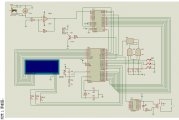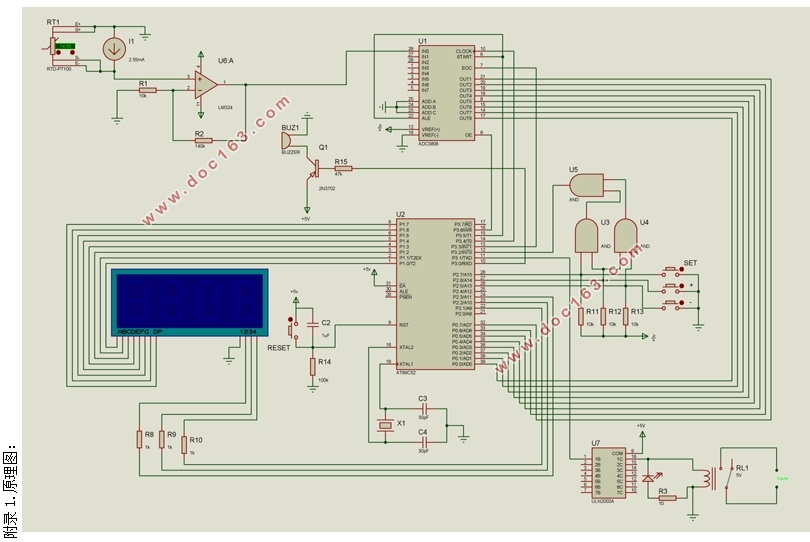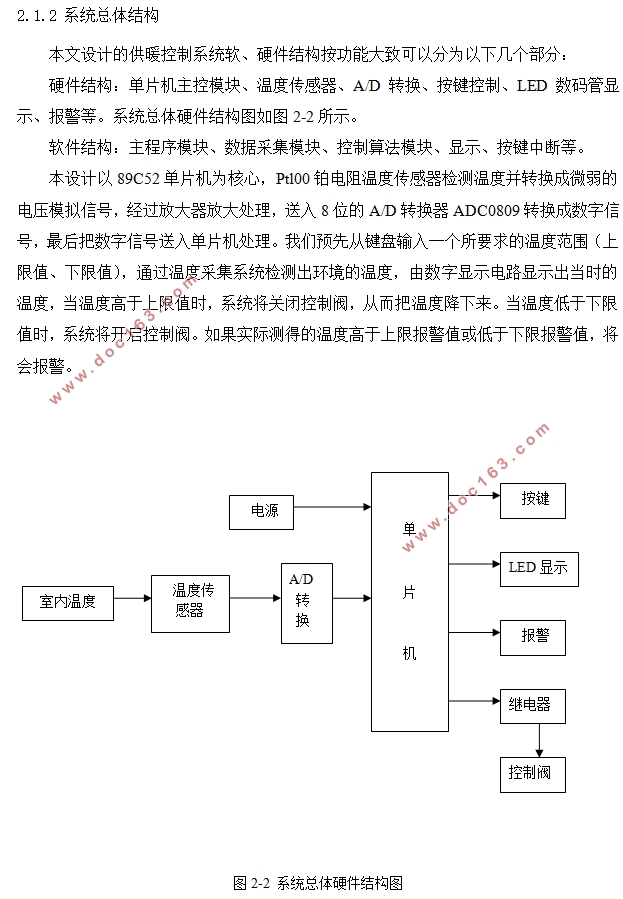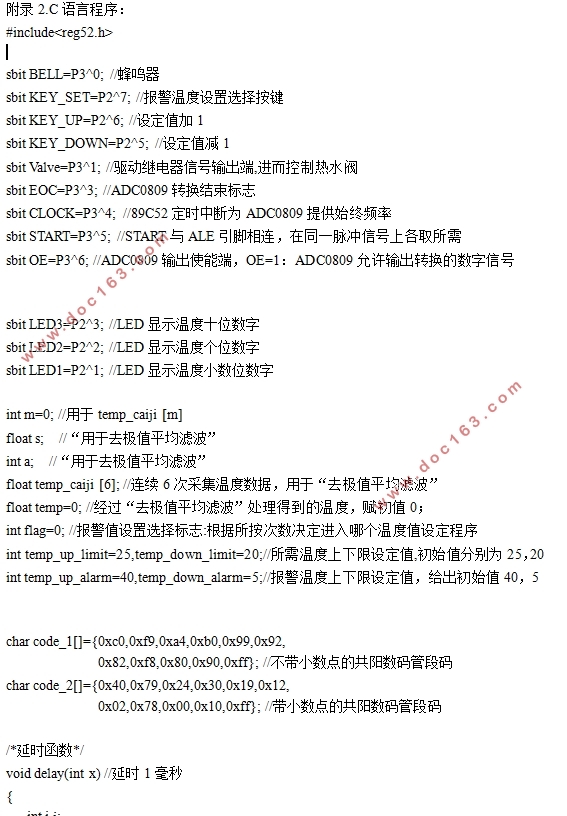基于单片机的全自动供暖温度控制系统设计

基于单片机的全自动供暖温度控制系统设计(论文20000字)
摘 要
集中供暖具有能源利用率高、供热成本低、污染少等优点,在世界各国得到了广泛应用。但集中供热系统是一个大滞后、非线性的复杂系统。在供暖季节,由于气温变化较大,要保持室内温度恒定,需要对系统进行调节。目前我国大多地区的供热调节都落后供热需求一步,不但供暖质量不理想,而且还造成了能源浪费。
本设计采用单片机和温度传感器对室内温度经行监控,通过热水阀门的开闭来实现对室温的控制。本设计以89C52单片机为核心,利用Pt100温度传感器实现对温度的采集,然后信号通过运算放大器、A/D转换器由模拟量变为数字量被送入单片机进行处理,最后单片机根据控制算法输出控制信号,控制热水阀门的开闭,从而控制室内的温度。本设计能够实现室内温度的实时显示,温度设定与控制,温度报警这些功能,实现了室内温度无人看管时的自动控制。
关键词: 集中供暖 单片机 温度监控 自动控制
The Design of Automatic Heating Temperature Control System Based on SCM
ABSTRACT
Central heating with high energy utilization rate, low heat supply cost, less pollution, has been widely used in the world. But the central heating system is a big lag, nonlinear and complex system. In the heating season, since the temperature changes greatly, to maintain the indoor temperature constant, the heating system needs some adjustments. At present, in most areas of our country, the heating regulation can’t satisfy the heating requirements, which causes not only heating quality bad, but also a great waste of energy.
This design can monitor the indoor temperature by using SCM and a temperature sensor, and realize the control of indoor temperature by adjust the valve to control hot water supply. The design is centered on AT89C52, using the PT100 temperature sensor to realize the collection of temperature, and then digital signals converted from analog signals through the operational amplifier and A/D converter is sent to the SCM for processing, and finally the SCM according to control algorithm outputs a control signal, which controls the switch of the valve of hot water to control the indoor temperature. The design can achieve functions of real-time display of indoor temperature, temperature alarm, and the set and control of temperature. This system realizes the unattended automatic control and the monitoring of indoor temperature.
Key words: Central heating; SCM; Temperature monitoring; Automatic control
1.3 设计任务及目标
设计任务:在寒冷的冬季,通过温度控制系统检测温度和控制室内的温度,使人们在舒适的环境下生活工作。采用89C52单片机为温度控制系统的核心,温度传感器,按键控制,A/D转换,显示模块等实现对整个中央供暖系统的动态测试、检测与报警、实时显示供热和供暖两项控制要求。 [资料来源:www.doc163.com]
设计目的要求:
1.设计控制系统的总体方案,画出整个系统的原理框图;
2.系统硬件设计
(1)单片机选择89C52,控制系统以89C52为核心 ;
(2)按键设定温度,并用LED数码管显示出来;
(3)用Pt100温度传感器检测温度,并用放大器放大检测到的电压模拟信号;
(4)使用ADC0809模数转换器将电压模拟信号转换成数字信号送入单片机处理;
(5)LED数码管显示测得的温度及设定的温度;
(6)当实际测得的温度值超过了系统给定的报警极限温度,将会报警。
3.系统软件设计
要求设计系统的算法流程图和具体软件实现。具体可分为如下几个模块:
(1)主程序模块
(2)数据(温度)采集模块
(3)控制算法模块
(4)显示模块
(5)按键中断模块
(6)报警模块
2.1 整体系统方案
2.1.1 系统原理
该系统原理如图2-1-1所示,供暖系统由热水锅炉、热水管道、散热器3个基本部分组成。供暖系统工作过程:用锅炉将水加热,然后用水泵将热水通过供热管道供给安装在室内的散热器中,热水通过散热器来加热室内空气。冷却的热水通过回水管道回到锅炉中再加热循环利用。 [资料来源:www.doc163.com]
该系统的控制器直接控制电磁阀,电磁阀调节散热器内热水的流量,从而达到控制室内温度的目的。该控制器以89C52单片机为核心,Ptl00铂电阻温度传感器检测温度并转换成微弱的电压模拟信号,经过放大器放大处理,送入8位的A/D转换器ADC0809转换成数字信号,最后把数字信号送入单片机处理。单片机根据所设定的温度范围以及当前温度输出控制信号,控制电磁阀的状态。
[资料来源:https://www.doc163.com]



目 录
摘 要 Ⅰ
ABSTRACT Ⅱ
第1章 绪论 1
1.1 课题背景 1
1.2 课题的意义 3
1.3 设计任务及目标 3
第2章 系统总体结构 5
[来源:http://www.doc163.com]
2.1 整体系统方案 5
2.1.1 系统原理 5
2.1.2 系统总体结构 6
2.2 开发工具简介 7
第3章 硬件设计 9
3.1 主机控制电路 9
3.1.1 单片机的选型 9
3.1.2 主控电路设计 12
3.2 温度监测电路 13
3.2.1 温度传感器的类型 13
3.2.2 温度传感器选择 14
3.2.3 放大器的选择 16
3.2.4 测温电路设计 16
3.3 A/D转换 17
3.3.1 A/D转换器的选择 17
3.3.2 A/D转换器的性能指标 18
3.3.3 A/D转换芯片ADC0809 19
3.4 显示电路 22
3.4.1 显示元件选择 22
3.4.2 LED显示器件的工作原理 22
3.4.3 LED显示电路设计 23
3.5 报警系统的设计 24
3.6 键盘控制电路设计 25
3.7 继电器驱动电路设计 25
3.7.1 继电器简介 25
3.7.2 驱动芯片ULN2003A 26
3.7.3 继电器驱动电路 27
第4章 软件设计 28
4.1 主程序设计 28
4.2 数据采集模块 29
4.2.1 A/D转换模块 29
4.2.2 数据处理模块 30
4.3 控制运算模块 32
4.4 显示模块 33
4.5 报警模块 35
4.6 键盘中断模块 36
4.7 系统调试 38
第5章 设计结果 39
第6章 结论 43
参考文献 44
致谢 45
附录 46
[来源:http://Doc163.com]
